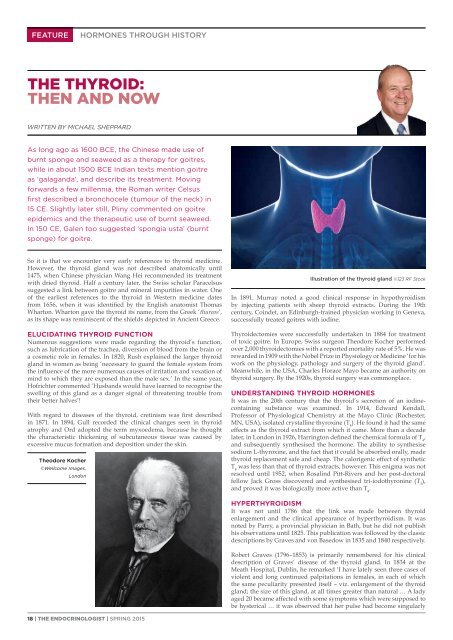1CIShci
1CIShci
1CIShci
You also want an ePaper? Increase the reach of your titles
YUMPU automatically turns print PDFs into web optimized ePapers that Google loves.
FEATURE<br />
HORMONES THROUGH HISTORY<br />
THE THYROID:<br />
THEN AND NOW<br />
WRITTEN BY MICHAEL SHEPPARD<br />
As long ago as 1600 BCE, the Chinese made use of<br />
burnt sponge and seaweed as a therapy for goitres,<br />
while in about 1500 BCE Indian texts mention goitre<br />
as ‘galaganda’, and describe its treatment. Moving<br />
forwards a few millennia, the Roman writer Celsus<br />
first described a bronchocele (tumour of the neck) in<br />
15 CE. Slightly later still, Pliny commented on goitre<br />
epidemics and the therapeutic use of burnt seaweed.<br />
In 150 CE, Galen too suggested ‘spongia usta’ (burnt<br />
sponge) for goitre.<br />
So it is that we encounter very early references to thyroid medicine.<br />
However, the thyroid gland was not described anatomically until<br />
1475, when Chinese physician Wang Hei recommended its treatment<br />
with dried thyroid. Half a century later, the Swiss scholar Paracelsus<br />
suggested a link between goitre and mineral impurities in water. One<br />
of the earliest references to the thyroid in Western medicine dates<br />
from 1656, when it was identified by the English anatomist Thomas<br />
Wharton. Wharton gave the thyroid its name, from the Greek ‘thureos’,<br />
as its shape was reminiscent of the shields depicted in Ancient Greece.<br />
ELUCIDATING THYROID FUNCTION<br />
Numerous suggestions were made regarding the thyroid’s function,<br />
such as lubrication of the trachea, diversion of blood from the brain or<br />
a cosmetic role in females. In 1820, Rush explained the larger thyroid<br />
gland in women as being ‘necessary to guard the female system from<br />
the influence of the more numerous causes of irritation and vexation of<br />
mind to which they are exposed than the male sex.’ In the same year,<br />
Hofrichter commented ‘Husbands would have learned to recognise the<br />
swelling of this gland as a danger signal of threatening trouble from<br />
their better halves’!<br />
With regard to diseases of the thyroid, cretinism was first described<br />
in 1871. In 1894, Gull recorded the clinical changes seen in thyroid<br />
atrophy and Ord adopted the term myxoedema, because he thought<br />
the characteristic thickening of subcutaneous tissue was caused by<br />
excessive mucus formation and deposition under the skin.<br />
Theodore Kocher<br />
©Wellcome Images,<br />
London<br />
Illustration of the thyroid gland ©123 RF Stock<br />
In 1891, Murray noted a good clinical response in hypothyroidism<br />
by injecting patients with sheep thyroid extracts. During the 19th<br />
century, Coindet, an Edinburgh-trained physician working in Geneva,<br />
successfully treated goitres with iodine.<br />
Thyroidectomies were successfully undertaken in 1884 for treatment<br />
of toxic goitre. In Europe, Swiss surgeon Theodore Kocher performed<br />
over 2,000 thyroidectomies with a reported mortality rate of 5%. He was<br />
rewarded in 1909 with the Nobel Prize in Physiology or Medicine ‘for his<br />
work on the physiology, pathology and surgery of the thyroid gland’.<br />
Meanwhile, in the USA, Charles Horace Mayo became an authority on<br />
thyroid surgery. By the 1920s, thyroid surgery was commonplace.<br />
UNDERSTANDING THYROID HORMONES<br />
It was in the 20th century that the thyroid’s secretion of an iodinecontaining<br />
substance was examined. In 1914, Edward Kendall,<br />
Professor of Physiological Chemistry at the Mayo Clinic (Rochester,<br />
MN, USA), isolated crystalline thyroxine (T 4<br />
). He found it had the same<br />
effects as the thyroid extract from which it came. More than a decade<br />
later, in London in 1926, Harrington defined the chemical formula of T 4<br />
,<br />
and subsequently synthesised the hormone. The ability to synthesise<br />
sodium L-thyroxine, and the fact that it could be absorbed orally, made<br />
thyroid replacement safe and cheap. The calorigenic effect of synthetic<br />
T 4<br />
was less than that of thyroid extracts, however. This enigma was not<br />
resolved until 1952, when Rosalind Pitt-Rivers and her post-doctoral<br />
fellow Jack Gross discovered and synthesised tri-iodothyronine (T 3<br />
),<br />
and proved it was biologically more active than T 4<br />
.<br />
HYPERTHYROIDISM<br />
It was not until 1786 that the link was made between thyroid<br />
enlargement and the clinical appearance of hyperthyroidism. It was<br />
noted by Parry, a provincial physician in Bath, but he did not publish<br />
his observations until 1825. This publication was followed by the classic<br />
descriptions by Graves and von Basedow in 1835 and 1840 respectively.<br />
Robert Graves (1796–1853) is primarily remembered for his clinical<br />
description of Graves’ disease of the thyroid gland. In 1834 at the<br />
Meath Hospital, Dublin, he remarked ‘I have lately seen three cases of<br />
violent and long continued palpitations in females, in each of which<br />
the same peculiarity presented itself – viz. enlargement of the thyroid<br />
gland; the size of this gland, at all times greater than natural … A lady<br />
aged 20 became affected with some symptoms which were supposed to<br />
be hysterical … it was observed that her pulse had become singularly<br />
18 | THE ENDOCRINOLOGIST | SPRING 2015


